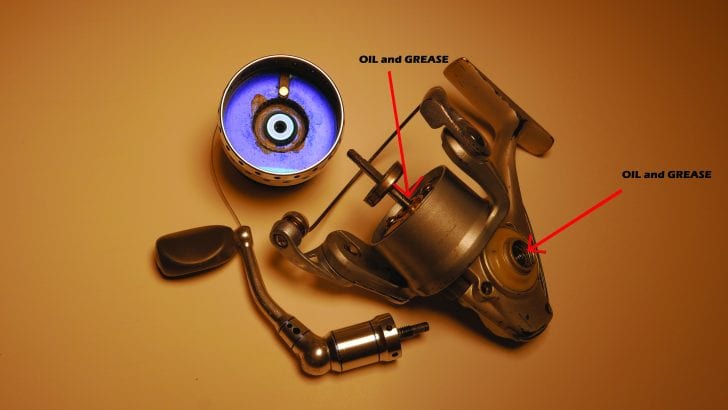Working our way through January into the month of February in the Lowcountry can be slow when it comes to inshore fishing.
I have mentioned before that two of the primary species local anglers like to fish for during these months is Winter Spotted Seatrout and Sheepshead, but January and February being the two coldest months of the year in South Carolina, may result in some down time, especially if the water temperature reaches the low 40’s.
This could cause fish kills and will also force fish to move out to deeper water, making it hard, if not impossible, to fish. So, when I cannot fish, what do I do during this down time?
Fishing also has other chores to attend to, and some of them, should be maintaining your fishing reels and rods, especially after a long season of use. Please allow me to share some of my methods that I use to maintain my reels and rods during the slow season.
First, let’s start with a few items you will need to help with this task. You will need a spray bottle of glass cleaner. This works great because it dries quickly, is not acidic and will easily remove salt and grime off of your fishing rods and reels (exterior use only).
You will also need some cotton rags. Soft cotton rags are not abrasive and polish rods and reels with ease. You will also need a small set of mechanic screwdrivers, a small adjustable wrench, a jar of reel oil and a tube of grease.
I personally recommend White Lithium Grease but not out of an aerosol can.
Lithium Grease out of an aerosol can will also have an acetone in them and may damage your fishing reel. White Lithium Grease from a tube does not contain an aerosol or acetone.
You can find this grease at your local auto parts stores. A brand I commonly use is Permatex. Why do I recommend White Lithium Grease? Because it not only lubricates but it is completely water resistant, especially to saltwater.
It also helps protect aluminum from oxidizing, which is very common when fishing in saltwater. Regular grease will not accomplish this. Most anglers will fish with a spinning reel, but there are also a number of anglers that will fish with bait cast reels as well.
If you have the original documentation for your reel, they may include a breakdown schematic. If so, reviewing the schematic to familiarize yourself with the reel’s components may help in its maintenance. Let’s start.
For a simple maintenance, take your glass cleaner and spray your reel down thoroughly. Then take your soft cotton rag and wipe your reel down all over, removing the dust, sand and dirt from the reel.
It should stick to your rag easily and a glass cleaner containing ammonia should evaporate quickly. Next remove the spool from the reel. This will expose the oscillation shaft, which is the shaft that moves up and down with the spool when reeling. This is where you will want to apply a small drop of oil first.
After applying the oil, turn the handle on your reel, allowing the oscillation shaft to move up and down and spread the oil evenly. Next take a small amount of grease and apply it to the shaft and repeat turning the handle on your reel. Next remove the handle from your reel.
For some spinning reels, the handle will screw into the reel directly. You can remove these handles by turning the handle backwards, which will cause the handle to unscrew. The opposite side of the reel should have a small cap screwed in. Remove the small cap.
After the handle is removed and the cap is removed, this should expose either the main bushings or ball bearings.
Place a small drop of oil in both sides, then apply a small drop of grease on both sides.
Reinstall your cap and your handle and then turn the reel handle for a few minutes, allowing the oil and grease to cover and coat the bushings or bearings. Other spinning reels may have a handle that inserts through the reel with a screw on the opposite side.
These handles will come off by unscrewing the cap and screw on the other side of the handle. Then please follow the same steps explained above. If you believe you are mechanically inclined and would like to take it a step further, you may refer to your reel’s schematic and remove the side plate from the reel, exposing the gears.
You may then apply a small amount of oil then a small amount of grease to the gears. Then reinstall your side plate and other parts that had to be removed in order to go this far, if any, it depends on your reel.
There are many bait cast reels, and most of them are designed differently, but all of them should allow access to the spool and spool bearings.
For instance, Garcia 6600 Series have three screws on the handle side of the bait caster, once loosened, it allows you to remove the whole gear box from the main frame, which will also allow you to remove the spool out of the reel.
This will expose the bushings or bearings on the spool that will need to be oiled and greased. It would be entirely up to you to find out how to access these components of your model reels. Fishing rods are a lot easier to maintain. Simply take a soft cotton rag and some soapy water and scrub your rod down thoroughly, then rinse your rod under clean, cold water, then dry your rod down evenly.
Occasionally, I go the extra step of spraying my rod down with glass cleaner and polishing it with a nice soft, dry cotton cloth. Before you know it, you are looking at your shiny rods and your clean, sparkly fishing reels and filled yourself with a sense of accomplishment, but at the same time you find yourself peeking out the window, checking out the weather, and then you realize you just made yourself miss the water even more!
I hope sharing some of my down time chores with you may help you keep your precious fishing equipment working smooth and looking good, anticipating their next day on the water, and like I always say, good luck out there and have fun fishing! To view some fishing adventures, go to my “Fishing with Jiggin Jerry” Channel on YouTube or go to www.jigginjerry.net.
You may also enjoy reading Winter Seatrout ~ By Jiggin’ Jerry








